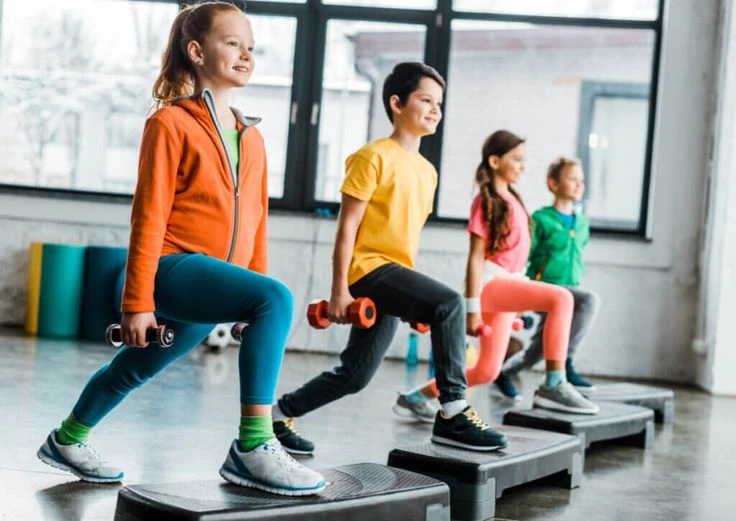Introduction:
In today’s fast-paced world, students are constantly juggling academics, extracurricular activities, and social commitments. Amidst this busy schedule, one aspect that often takes a backseat is fitness. However, maintaining physical health is not just about looking good—it’s about feeling good, performing better, and building a foundation for a healthy future. The importance of fitness in a student’s life cannot be overstated, as it plays a crucial role in shaping both physical and mental well-being.
From boosting academic performance to reducing stress, fitness offers a myriad of benefits that go beyond the gym or sports field. For students, staying active is not just a lifestyle choice; it’s a necessity to thrive in their personal and academic lives. Whether it’s through yoga, team sports, or simple daily exercises, incorporating fitness into a student’s routine can lead to improved focus, higher energy levels, and a stronger immune system.
But how can students balance their packed schedules with fitness? What are the best ways to stay active without compromising on studies? In this blog post, we’ll explore the importance of fitness in a student’s life, its undeniable benefits, and practical tips to help students stay active and healthy. Whether you’re a high school student, a college-goer, or a parent looking to guide your child, this guide will provide actionable insights to make fitness a seamless part of daily life.
1. Why Fitness is Essential for Students
In the hustle and bustle of academic life, fitness often takes a backseat. However, staying physically active is not just a luxury—it’s a necessity for students. Fitness plays a pivotal role in shaping a student’s overall well-being, from physical health to mental clarity. Let’s explore why fitness is essential for students and how it can transform their lives.
Improves Physical Health and Immunity
Regular physical activity is the cornerstone of good health. For students, who are often exposed to stress and irregular routines, fitness helps strengthen the immune system, reducing the risk of illnesses. Activities like running, swimming, or even brisk walking improve cardiovascular health, build muscle strength, and enhance flexibility. A strong body not only keeps students energized but also ensures they can keep up with the demands of their busy schedules.
Boosts Mental Clarity and Academic Performance
Fitness and academics go hand in hand. Studies have shown that students who engage in regular physical activity tend to perform better academically. Exercise increases blood flow to the brain, improving concentration, memory, and problem-solving skills. Whether it’s a quick workout before class or a yoga session during study breaks, fitness helps students stay sharp and focused, making it easier to tackle complex subjects and exams.
Reduces Stress and Enhances Emotional Well-being
The pressure of deadlines, exams, and social expectations can take a toll on a student’s mental health. Fitness acts as a natural stress reliever by releasing endorphins, the body’s “feel-good” hormones. Activities like yoga, meditation, or even a simple jog can help students unwind, combat anxiety, and maintain a positive outlook. A healthy mind is just as important as a healthy body, and fitness ensures both are in sync.
Builds Discipline and Time Management Skills
One of the most underrated benefits of fitness is its ability to instill discipline and time management. Balancing workouts with studies teaches students how to prioritize tasks, set goals, and stick to a routine. These skills are not only essential for academic success but also for personal and professional growth. By incorporating fitness into their daily lives, students learn the value of consistency and perseverance.
2. Key Benefits of Fitness in a Student’s Life
Fitness is more than just a way to stay in shape—it’s a powerful tool that can positively impact every aspect of a student’s life. From boosting academic performance to enhancing social skills, the benefits of fitness are far-reaching. Let’s dive into the key advantages that make fitness an essential part of a student’s routine.
Enhances Focus and Productivity in Studies
One of the most significant benefits of fitness for students is its ability to improve focus and productivity. Physical activity increases blood flow to the brain, which enhances cognitive functions like memory, attention, and problem-solving. Whether it’s a quick workout before hitting the books or a yoga session during study breaks, fitness helps students stay alert and engaged. This translates to better performance in exams and a deeper understanding of complex subjects.
Promotes Better Sleep and Energy Levels
Students often struggle with irregular sleep patterns due to late-night study sessions or stress. Regular exercise can help regulate sleep cycles, ensuring students get the rest they need to recharge. Activities like jogging, swimming, or even stretching can reduce insomnia and improve sleep quality. Better sleep, in turn, leads to higher energy levels throughout the day, helping students stay active and focused in class.
Encourages Social Interaction Through Team Sports
Fitness isn’t just about individual workouts—it’s also a great way to build social connections. Participating in team sports like basketball, soccer, or volleyball allows students to interact with peers, develop teamwork skills, and form lasting friendships. These social interactions are crucial for emotional well-being and can help students feel more connected and supported in their academic journey.
Builds Confidence and Self-Esteem
Regular physical activity can do wonders for a student’s self-confidence. Achieving fitness goals, whether it’s running a mile or mastering a new yoga pose, gives students a sense of accomplishment. This boost in self-esteem extends beyond the gym or sports field, empowering students to tackle academic challenges and personal goals with a positive mindset. A confident student is more likely to participate in class, take on leadership roles, and excel in various aspects of life.
3. How to Stay Active as a Student
Balancing academics, extracurricular activities, and social life can make it challenging for students to find time for fitness. However, staying active doesn’t have to be time-consuming or complicated. With a few simple strategies, students can seamlessly integrate physical activity into their daily routines. Here are some practical tips to help students stay active and healthy.
Incorporate Physical Activity into Your Daily Routine
Small changes can make a big difference. Students can stay active by incorporating movement into their everyday activities. For example:
- Walk or cycle to school or college instead of taking public transport or driving.
- Take the stairs instead of the elevator.
- Do stretches or light exercises while watching TV or during study breaks.
These small habits add up over time and help students stay active without needing to set aside extra hours for the gym.
Join School or College Sports Teams or Fitness Clubs
Participating in organized sports or fitness clubs is a fun and effective way to stay active. Most schools and colleges offer a variety of options, such as:
- Team sports like basketball, soccer, or volleyball.
- Fitness clubs for yoga, dance, or martial arts.
- Intramural leagues for casual players.
Joining these groups not only promotes physical activity but also provides opportunities to socialize and build teamwork skills.
Use Short Workout Sessions (e.g., 20-Minute Home Workouts)
For students with packed schedules, short and efficient workouts can be a game-changer. Here are some ideas:
- High-Intensity Interval Training (HIIT): A 20-minute HIIT session can burn calories and boost energy levels.
- Bodyweight exercises: Push-ups, squats, and planks require no equipment and can be done anywhere.
- Online workout videos: Platforms like YouTube offer free fitness routines tailored to students’ needs.
These quick workouts are perfect for busy days and can easily fit into a student’s routine.
Take Active Breaks During Study Sessions
Sitting for long periods can lead to fatigue and reduced productivity. Students can stay active by incorporating movement into their study routines:
- Pomodoro Technique: Study for 25 minutes, then take a 5-minute active break (e.g., stretching, jumping jacks, or a quick walk).
- Desk exercises: Simple stretches or seated leg lifts can keep the body engaged.
- Walk and talk: Use phone calls or group study sessions as an opportunity to walk around.
These active breaks not only improve physical health but also enhance focus and retention.
4. Best Fitness Activities for Students
Finding the right fitness activity can make staying active enjoyable and sustainable for students. The key is to choose activities that are fun, flexible, and fit into a busy schedule. Here are some of the best fitness activities for students, catering to different interests and fitness levels.
Yoga and Meditation for Mental and Physical Balance
Yoga is a perfect fitness activity for students as it combines physical exercise with mental relaxation. Benefits include:
- Improved flexibility and strength: Poses like downward dog and warrior stretches enhance physical fitness.
- Stress relief: Breathing exercises and meditation help students manage academic pressure.
- Convenience: Yoga can be done at home, in a park, or even in a dorm room with minimal equipment.
Apps and online tutorials make it easy for students to start their yoga journey, even as beginners.
Running, Jogging, or Brisk Walking for Cardiovascular Health
Running or jogging is one of the most accessible and effective ways to stay fit. It’s ideal for students because:
- No equipment needed: All you need is a good pair of running shoes.
- Flexible timing: Students can run early in the morning, during breaks, or in the evening.
- Boosts energy: Running releases endorphins, which improve mood and energy levels.
For those who prefer a lower-impact option, brisk walking is a great alternative that still provides cardiovascular benefits.
Strength Training with Bodyweight Exercises
Strength training doesn’t require a gym membership or heavy equipment. Students can build muscle and endurance using their own body weight:
- Push-ups: Strengthen the upper body and core.
- Squats: Target the legs and glutes.
- Planks: Improve core strength and stability.
These exercises can be done in small spaces, making them perfect for dorm rooms or home workouts. Adding resistance bands or light dumbbells can increase intensity over time.
Team Sports for Fun and Fitness
Team sports are a fantastic way for students to stay active while having fun and socializing. Popular options include:
- Basketball: Improves agility, coordination, and teamwork.
- Soccer: Enhances cardiovascular fitness and leg strength.
- Volleyball: Builds upper body strength and reflexes.
Many schools and colleges have intramural leagues or casual pickup games, making it easy for students to join in.
Dance Workouts for Creativity and Cardio
Dance is a fun and energetic way to stay fit, especially for students who enjoy music and movement. Benefits include:
- Cardiovascular health: Dance routines get the heart pumping.
- Stress relief: Dancing is a great way to unwind and express creativity.
- Social interaction: Joining a dance class or group can help students meet new people.
From Zumba to hip-hop, there’s a dance style for everyone.
5. Tips for Balancing Fitness and Studies
Balancing fitness and studies can seem challenging, but with the right strategies, students can achieve both without compromising either. The key is to prioritize, plan, and stay consistent. Here are some practical tips to help students maintain a healthy balance between their academic and fitness goals.
Create a Weekly Fitness Schedule and Stick to It
Planning is essential for balancing fitness and studies. Students can:
- Set specific workout times: Dedicate certain days and times for exercise, just like classes or study sessions.
- Use a planner or app: Tools like Google Calendar or fitness apps can help track workouts and academic deadlines.
- Start small: Begin with 2-3 workouts per week and gradually increase as it becomes a habit.
Having a schedule ensures that fitness becomes a non-negotiable part of the routine.
Combine Study Breaks with Quick Exercises
Studying for long hours can lead to fatigue and reduced productivity. Students can use study breaks to incorporate physical activity:
- Pomodoro Technique: Study for 25 minutes, then take a 5-minute active break (e.g., stretching, jumping jacks, or a quick walk).
- Desk exercises: Simple stretches, seated leg lifts, or shoulder rolls can keep the body active.
- Walk and talk: Use phone calls or group study sessions as an opportunity to walk around.
These mini-workouts help refresh the mind and body, making study sessions more effective.
Use Fitness Apps or Trackers to Monitor Progress
Technology can be a great ally in balancing fitness and studies. Students can:
- Track workouts: Apps like MyFitnessPal, Nike Training Club, or Strava help monitor exercise routines and progress.
- Set goals: Use fitness trackers or smartwatches to set daily step goals or calorie targets.
- Stay motivated: Many apps offer reminders, challenges, and rewards to keep students on track.
Tracking progress not only provides a sense of accomplishment but also helps maintain consistency.
Prioritize Consistency Over Intensity to Avoid Burnout
It’s better to stay consistent with moderate exercise than to push too hard and burn out. Students should:
- Focus on sustainability: Choose activities they enjoy and can maintain long-term.
- Avoid overtraining: Balance intense workouts with rest days to prevent fatigue or injury.
- Listen to their bodies: Adjust workout intensity based on energy levels and academic workload.
Consistency ensures that fitness becomes a sustainable part of their lifestyle.
Multitask When Possible
Students can combine fitness with other activities to save time:
- Active commuting: Walk or cycle to school or college instead of driving or taking public transport.
- Study while moving: Use a standing desk or treadmill desk to stay active while studying.
- Group fitness: Join study groups that incorporate physical activities, like walking discussions or yoga breaks.
Multitasking helps students make the most of their time without sacrificing fitness or academics.
Stay Flexible and Adapt to Changes
Life as a student can be unpredictable, with exams, projects, and social events often disrupting routines. To stay on track:
- Adjust workouts: Shorten or modify exercises during busy periods (e.g., replace a gym session with a 15-minute home workout).
- Be kind to themselves: It’s okay to miss a workout occasionally—what matters is getting back on track.
- Celebrate small wins: Acknowledge progress, no matter how small, to stay motivated.
Flexibility ensures that fitness remains a priority without adding unnecessary stress.
Conclusion:
Fitness is not just a hobby—it’s a vital component of a student’s overall well-being. From improving physical health and boosting academic performance to reducing stress and building confidence, the benefits of staying active are undeniable. As we’ve explored in this blog post, fitness doesn’t have to be time-consuming or complicated. With simple strategies like creating a workout schedule, taking active study breaks, and choosing enjoyable activities, students can seamlessly integrate fitness into their busy lives.
Remember, the goal isn’t perfection but consistency. Whether it’s a 20-minute home workout, a yoga session, or a game of basketball with friends, every bit of movement counts. By prioritizing fitness, students can unlock their full potential, both inside and outside the classroom.
So, what are you waiting for? Take the first step today. Start small, stay consistent, and watch how fitness transforms your life. Share your fitness journey in the comments below, or let us know which tip resonated with you the most. Together, let’s build a healthier, happier, and more productive student community!
Make Fitness a Priority for a Healthier, Happier Student Life



